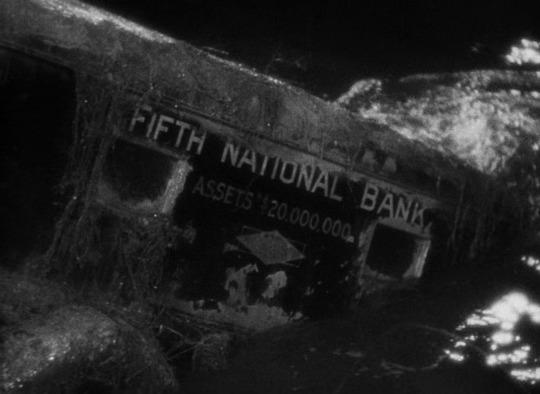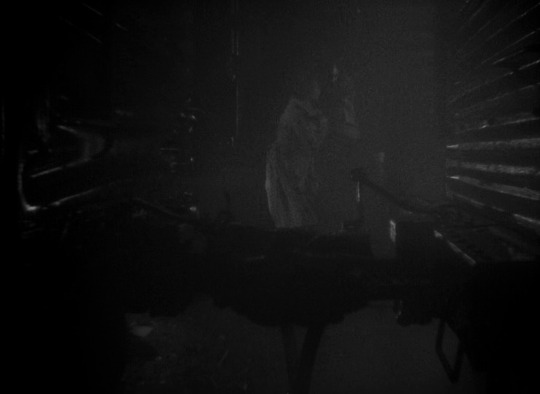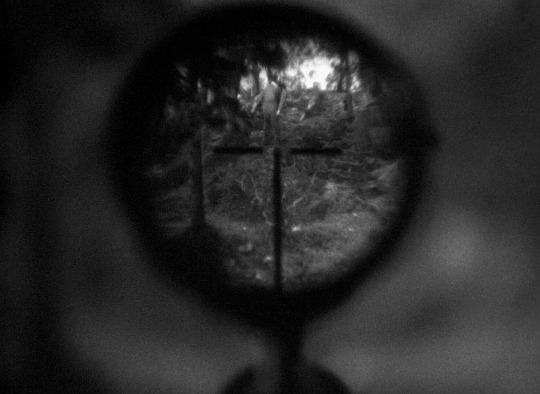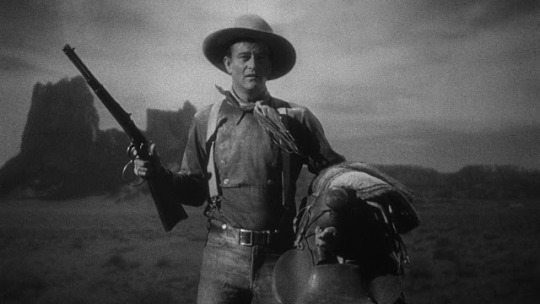#Alexander Toluboff
Text










You Only Live Once (Fritz Lang, 1937).
18 notes
·
View notes
Photo

John Wayne in Stagecoach (John Ford, 1939)
Cast: John Wayne, Claire Trevor, Thomas Mitchell, John Carradine, George Bancroft, Andy Devine, Louise Platt, Donald Meek, Berton Churchill, Tim Holt, Tom Tyler. Screenplay: Dudley Nichols, based on a story by Ernest Haycox. Cinematography: Bert Glennon. Art direction: Alexander Toluboff. Film editing: Otho Lovering, Dorothy Spencer. Music: Gerard Carbonara.
Stagecoach breaks a lot of rules: The celebrated sequence in which the Apaches chase the stagecoach is filmed from various angles instead of adhering to the practice of keeping the action moving in one direction across the screen. Some of its climactic moments, such as the final showdown between Ringo (John Wayne) and the Plummer brothers, occur offscreen. And the whole film is a bewilderment of locations, with John Ford's beloved Monument Valley showing up whenever Ford wants to use it, and not when it matches the location of the previous shots. The great example of this last is the introduction of the Ringo Kid himself, a flourish of camerawork that zooms in on Ringo with a Monument Valley butte in the background, no matter that neither lighting nor lenses nor the ordinary scrubby landscape of the scenes that frame this moment match up. Clearly, Ford wanted to give the moment a special magic, establishing the character as the film's hero -- even though Wayne, a veteran of B-movies, was forced to take second billing to the better-known Claire Trevor. The magic worked, to be sure: Wayne became a central figure in the American mythology. If Stagecoach had been a flop, American movies would have been quite different. John Ford would have been known as a director of solid "prestige" films like The Informer (1935), The Grapes of Wrath (1940), and How Green Was My Valley (1941), three of the record-setting four pictures for which won the best director Oscar.* and not as the man who turned the Western into the essential American genre. Wayne might have stayed in B-movies, at least until the outbreak of World War II made him a good catch for war pictures. But Stagecoach would never have been a flop: It's too cannily written, directed, and cast not to succeed. It is essential entertainment, cliché-ridden and sometimes clumsy, too obvious by half, but it draws you in irresistibly with its revenge plotting, its damsels in distress, and its social commentary -- the blustering crooked banker Gatewood (Berton Churchill) is far more of a lefty caricature than Wayne or even Ford would have wanted to be associated with later in their careers, and probably owes more to Dudley Nichols's political leanings than to Ford's.
*The fourth was The Quiet Man (1952), which like the other three was not a Western, even though it starred John Wayne. That Ford never won for a Western is one of the many anomalies of the Academy Awards.
1 note
·
View note
Photo

365 Day Movie Challenge (2017) - #345: Algiers (1938) - dir. John Cromwell
Moving at the pace of a French film from the same era and bearing a similarly moody atmosphere, Algiers is a decidedly entertaining drama about crime, intrigue and forbidden romance in the city’s famed Casbah. John Cromwell’s film, a remake of Julien Duvivier’s Pépé le Moko (1937) and independently released by Walter Wanger Productions/United Artists, was a hit that earned four Oscar nominations: Best Actor (Charles Boyer), Best Supporting Actor (Gene Lockhart), Best Cinematography (James Wong Howe) and Best Art Direction (Alexander Toluboff). I assure you that all the nods were well-earned.
Throughout the film, jewel thief Pépé le Moko (Boyer) is pursued by police, including the deceptively friendly Inspector Slimane (Joseph Calleia). Pépé is surrounded by various pals, including Ines (Sigrid Gurie), Grandpere (Alan Hale), Regis (Lockhart), Carlos (Stanley Fields), Pierrot (Johnny Downs), L’Arbi (Leonid Kinskey), Aicha (Joan Woodbury), Tania (Nina Koshetz) and Gil (Ben Hall); outside of this circle, however, Pépé finds himself drawn to Gaby (Hedy Lamarr), an alluring young Frenchwoman who is vacationing in Algiers prior to her marriage to a much older man, Andre Giraux (Robert Greig).
Sigrid Gurie’s Ines gets more screen time than Hedy Lamarr’s Gaby, and Gurie gives the better performance, but it’s Lamarr - making her American debut here - who makes the stronger impression. There is no doubt as to why Lamarr, who glows with radiant beauty in the film, shot to international superstardom immediately afterward. Charles Boyer is drawn to her like a moth to a flame, and although we can tell that this union will not have a happy ending (typical for a Boyer drama), there is immense pleasure in following the couple’s love story. Algiers may not have provided much of an acting challenge for Hedy Lamarr - whose birthday was a couple of days ago, hence my interest in watching the film - but it is a good reminder of why Hollywood fell under her spell in the first place.
#365 day movie challenge 2017#algiers#1938#1930s#30s#john cromwell#old hollywood#charles boyer#gene lockhart#james wong howe#alexander toluboff#joseph calleia#sigrid gurie#alan hale#stanley fields#johnny downs#leonid kinskey#joan woodbury#nina koshetz#ben hall#hedy lamarr#robert greig#walter wanger#united artists
5 notes
·
View notes
Text
“WUTHERING HEIGHTS” (1939) Review

"WUTHERING HEIGHTS" (1939) Review
Considering the popularity of the Brontë sisters, it is not surprising that there have been considerable movie, stage and television adaptations of their novels. I discovered there have been at least fifteen (15) adaptations of Emily Brontë's 1847 novel, "Wuthering Heights".
I might as well be frank . . . I am not a major fan of the novel. I never have been. I do not dislike it, but I have always preferred the famous novels of the author's two sisters - namely "Jane Eyre" (1847) by Charlotte Brontë and Anne Brontë's 1848 novel, "The Tenant of Wildfell Hall". For some reason, "Wuthering Heights" depresses the hell out of me. I have nothing against works of fiction laced with tragedy. But the heavy barrage of emotional and physical abuse, revenge, and over-the-top passion has always seemed a bit too much for me. Due to my less-than-enthusiastic regard for Ms. Brontë's novel, I have always been reluctant to watch any of the television or movie adaptations, with the exception of one - the 1939 movie produced by Samuel Goldwyn.
Directed by William Wyler, and starring Merle Oberon and Laurence Olivier; "WUTHERING HEIGHTS" told the story of the passionate and doomed love story between one Catherine Earnshaw, the daughter of a Yorkshire landowner and an orphaned Gypsy boy named Heathcliff. The story opens with Mr. Earnshaw introducing Heathcliff to his family - Cathy and her brother, Hindley - at Wuthering Heights. While Cathy immediately befriends Heathcliff, Hindley becomes jealous of his father and sister's high regard of the newcomer. Heathcliff's pleasant life with the Earnshaw family ends when Mr. Earnshaw dies and a resentful Hindley forces him to become one of the family's servants.
Despite Heathcliff's new status within the Earnshaw family, his close relationship with Cathy remains close. Some eight to ten years later, the now adult pair have fallen in love and are meeting secretly on Penniston's Crag. One night, Cathy and Heathcliff are out when they discover the Earnshaws' neighbors, the Lintons, giving a party at the Grange. After climbing the garden wall, Cathy is attacked by a dog. The Lintons take Cathy in to care for her and Heathcliff is ordered to leave the Grange. Cathy becomes close with Edgar Linton and entranced by his wealth and glamour, while Edgar falls in love with her. When Edgar decides to propose marriage to Cathy, his action leads to a major fallout between Cathy and Heathcliff, the latter's departure for United States, his return, jealousy, obsession and in the end, tragedy.
As far as I know, the 1939 film eliminated the second half of Brontë's novel that centered on the generation featuring Heathcliff and Cathy's children. This elimination has led many fans of the novel to dismiss this version as a poor adaptation. Well, to each his own. I have never read Brontë's novel. And this is probably why I have such difficulty in dismissing "WUTHERING HEIGHTS" as unworthy of the novel. The only way I can judge the movie is on its own merits. And quite frankly, I believe it is one of the better costume dramas to be released during Hollywood's Studio Era.
Producer Samuel Goldwyn assigned his top director, William Wyler, to helm the movie. And Wyler did a superb job. Thanks to his direction, "WUTHERING HEIGHTS" turned out to be an atmospheric and well paced movie filled with superb performances by the cast. Wyler utilized the talents of cinematographer Gregg Toland, along with art designers James Basevi and Alexander Toluboff to re-create the novel's setting - the brooding Yorkshire moors with exquisite details.
The movie's most controversial aspect turned out to be Charles MacArthur and Ben Hecht's screenplay. Many present-day critics believe that the two screenwriters took the bite out of Brontë's novel by romanticizing Heathcliff and Cathy's relationship. Literary critic John Sutherland accused Wyler, Hecht and MacArthur of portraying Cathy as a more passive character, willing to accept Heathcliff's abuse. Personally, I cannot help but wonder how he came to this conclusion. My recent viewing of "WUTHERING HEIGHTS" recalls a capricious and manipulative Cathy unable to hold back her scorn of Heathcliff in the face of the Lintons' wealth and glamour; and a Cathy more than determined to prevent Heathcliff and Isabella Linton's marriage. Not once do I recall a passive Cathy willing to accept abuse from Heathcliff.
Other critics of the movie have also accused Wyler and the two screenwriters of robbing Heathcliff the opportunity to seek revenge against Cathy and the Linton family by deleting the second half of the novel. These same critics seemed to have forgotten that a good deal of the movie's second half focused not only on Heathcliff's return to England, but also his efforts to get revenge on both the Earnshaw and Linton families. He did this by acquiring Wuthering Heights from an increasingly dissolute Hindley Earnshaw and more importantly, seeking Isabella Linton's hand for marriage. The latter finally reached its mark as far as Cathy was concerned. The emotional damage from Heathcliff's marriage to Isabella led to Cathy's death and tragedy. The biggest criticism that emerged from "WUTHERING HEIGHTS" was Samuel Goldwyn's decision to set the story in the mid-Victorian era, instead of the novel's late 18th and early 19th centuries setting. It is believed that Goldwyn made this decision either because he preferred this period in costumes or he was simply trying to save a buck by using old Civil War era costumes. Personally, I could not care less. The novel's setting was merely accelerated by five to six decades. And since "WUTHERING HEIGHTS" did not utilize any historical facts in its plot, I see no reason to get upset over the matter.
"WUTHERING HEIGHTS" went into production as a vehicle for actress Merle Oberon, who was a contract player at Goldwyn Studios. When Laurence Olivier, her co-star from 1938's "THE DIVORCE OF LADY X", was cast as Heathcliff, he campaigned for lover Vivian Leigh to replace Oberon as Catherine Earnshaw. Olivier's efforts failed and Oberon kept her job. Many critics believe that Leigh would have done a better job. I refuse to accept or reject that belief. However, I was very impressed by Oberon's performance. She did an excellent job in capturing Cathy's capricious and shallow nature. Although Oberon had a few moments of hammy acting, she was not as guilty as two of her co-stars. I find it rather disappointing that she failed to earn an Academy Award nomination. Her scene with Geraldine Fitzgerald (in which Cathy tries to dampen Isabella's interest in Heathcliff) and the famous soliloquy that ended with Cathy's "I am Heathcliff" declaration should have earned her a nomination.
Laurence Olivier made his Hollywood debut in the role of the Gypsy orphan-turned-future owner of Wuthering Heights, Heathcliff. Olivier harbored a low opinion of Hollywood and screen acting in general. But Wyler's exhausting style of directing and tutelage enabled Olivier to drop his penchant for stage theatrics and perform for the camera. Mind you, I do not believe Wyler was not completely successful with Olivier. The actor still managed to display hints of hammy acting in his performance. And he did not seem that successful in his portrayal of a Heathcliff in his late teens or early twenties, in compare to Oberon, who seemed successful in portraying Cathy in that same age group. Regardless, Olivier gave a first-rate performance, and managed to earn the first of his ten Academy Award nominations.
Another performer who earned an Academy Award nomination was Geraldine Fitzgerald, for her performance as Isabella Linton. I cannot deny that she deserved the nomination. Fitzgerald gave a memorable performance as the passionate, naive and outgoing Isabella, who found herself trapped in an emotionally abusive marriage to a man that harbored no love for her. However, I believe that like Olivier, she was guilty of a few moments of histronic acting. I could never accuse David Niven of such a thing. The actor gave a solid performance as the quietly loving, yet privileged Edgar Linton. Flora Robson was superb as the story's narrator and Cathy Earnshaw's maid, Ellen Dean. And both Niven and Robson proved to be the production's backbone by being the only cast members that managed to refrain from any histronic acting altogether. I can also say the same about Hugh Williams' portrayal of the embittered and dissolute Hindley Earnshaw. Donald Crisp, Leo G. Carroll, Cecil Kellaway and Miles Mander also gave fine support.
I realize that "WUTHERING HEIGHTS" will never be a favorite of the fans of Brontë's novel. But as a movie fan, I cannot look down at this production. Thanks to William Wyler's direction, Gregg Toland's photography, solid adaptation by Ben Hecht and Charles MacArthur, and superb acting from a cast led by Merle Oberon and Laurence Olivier; it is quite easy to see why it is considered as one of the best examples of Old Hollywood during one of its best years - 1939. I guess I will always be a fan.
#emily bronte#bronte sisters#wuthering heights#wuthering heights 1939#William Wyler#old hollywood#samuel goldwyn#period drama#Laurence Olivier#merle oberon#david niven#geraldine fitzgerald#donald crisp#flora robson#hugh williams#leo g. carroll#cecil kellaway#miles mander#gregg toland
3 notes
·
View notes
Photo

You Only Live Once (Fritz Lang, 1937) | Art direction by Alexander Toluboff
24 notes
·
View notes
Photo










Wuthering Heights (William Wyler, 1939).
#wuthering heights#wuthering heights (1939)#william wyler#merle oberon#laurence olivier#gregg toland#daniel mandell#james basevi#alexander toluboff#julia heron#omar kiam#robert stephanoff#charles macarthur#ben hecht#emily brontë#john huston
108 notes
·
View notes
Photo










Wuthering Heights (William Wyler, 1939).
#Wuthering Heights (1939)#wuthering heights#william wyler#merle oberon#laurence olivier#gregg toland#daniel mandell#james basevi#alexander toluboff#julia heron#omar kiam#robert stephanoff#emily brontë#charles macarthur#ben hecht#john huston
59 notes
·
View notes
Photo










Stagecoach (John Ford, 1939).
#stagecoach (1939)#stagecoach#john ford#john wayne#john carradine#claire trevor#bert glennon#otho lovering#dorothy spencer#walter reynolds#alexander toluboff
198 notes
·
View notes
Photo










Stagecoach (John Ford, 1939).
#stagecoach#stagecoach (1939)#john ford#john wayne#claire trevor#bert glennon#otho lovering#dorothy spencer#walter reynolds#alexander toluboff#walter plunkett
106 notes
·
View notes
Photo










Stand-In (Tay Garnett, 1937).
#stand-in#stand-in (1937)#tay garnett#humphrey bogart#clarence budington kelland#gene towne#c. graham baker#charles g. clarke#otho lovering#dorothy spencer#alexander toluboff#helen taylor
32 notes
·
View notes
Photo

Ramon Novarro and Jeanette MacDonald in The Cat and the Fiddle (William K. Howard, 1934)
Cast: Ramon Novarro, Jeanette MacDonald, Frank Morgan, Charles Butterworth, Jean Hersholt, Vivienne Segal, Frank Conroy, Henry Armetta, Adrienne D'Ambicourt, Joseph Cawthorn. Screenplay: Bella Spewack, Sam Spewack, based on a play by Otto A. Harbach and Jerome Kern. Cinematography: Charles G. Clarke, Ray Rennahan, Harold Rosson. Art direction: Alexander Toluboff. Film editing: Frank E. Hull. Music: Herbert Stothart, songs by Jerome Kern and Otto A. Harbach.
The Cat and the Fiddle marks a change in Jeanette MacDonald's career: It was her first film for MGM after the classic series of witty, racy movies co-starring Maurice Chevalier at Paramount, and it neatly bridges her way into the more famous but less interesting operetta films she made with Nelson Eddy at MGM. Here her co-star is Ramon Novarro, a charming actor with great comic skills and a nice singing voice, but they don't mesh the way she did with either Chevalier or Eddy; she seems a little too stiff, he a little too boyish. Made before the full introduction of the Production Code, the movie tries for some of the sexiness of the Paramount films made under the aegis of the master of the sly wink, Ernst Lubitsch. The lovers, Novarro's Victor and MacDonald's Shirley, live together without benefit of clergy, a thing impossible under the code. There is fun to be had watching the film: The dialogue -- among the uncredited contributors to the screenplay are Anita Loos and James Kevin McGuinness -- is often smart and funny, the songs are pleasant, and the giddy nonsense of the plot skips along merrily. And at the end there's a nice surprise: The final reel is in Technicolor, giving audiences a first glimpse of MacDonald's red hair. But this is minor MGM musical stuff, even in comparison with the later MacDonald/Eddy movies.
3 notes
·
View notes